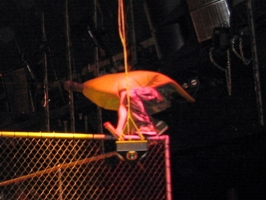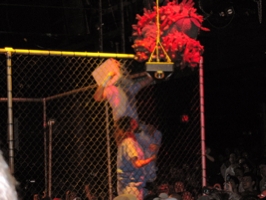Mike Grasso asked me what real-life Japanese pro wrestling (aka puroresu) was like. I can answer that question at more length than he probably imagined, and I’m gonna. Brace yourselves.
There are four distinct styles of Japanese pro wrestling at the moment. There’s a lot of crossover and blending of styles, but at the end of the day the four basic styles remain distinct. The first and oldest is strong style, which is the most like US pro wrestling. Second and third, in no particular order, are puroresu and garbage wrestling. Lucharesu is a cruiserweight style, heavily influenced both by Mexican lucha libre and Canadian technical wrestling. Garbage wrestling is the stuff with lightbulbs and thumbtacks and explosions and fire. Finally, and newest to the scene, there’s shoot wrestling; it’s a reaction to the popularity of mixed martial arts (such as the UFC).
Strong style is more or less the mainstream of Japanese wrestling. Up until the 1970s, Japanese wrestling was not noticably different from US wrestling. In the late 1970s and early 1980s, All Japan Pro Wrestling (AJPW, then one of the two biggest wrestling promotions in Japan) deliberately moved away from the cartoonish aspects of US wrestling. They made the conscious decision to eliminate false finishes, run-ins, and other gimmicks; they figured they’d attract more fans if they simulated a real sporting event better. It was a huge success. The desire for verisimilitude also resulted in higher impact moves; 80s and 90s AJPW was known for the number of times you’d see someone dropped on their head. Compare this to Memphis wrestling, in which the piledriver was “outlawed” in order to make the emotional impact of the move that much stronger.
Lucharesu really didn’t get going until the late 1980s, although the seeds of the style were sown years earlier. You can trace lucharesu to a classic series of matches between Tiger Mask I and Dynamite Kid. Some will remember Dynamite as half of the British Bulldogs; he was a British-born wrestler who trained in Calgary under the legendary Stu Hart. The Hart family and trainees have always been known for their devotion to technical wrestling; Tiger Mask I was fascinated by lucha libre. The fusion of these influences is lucharesu.
It’s a very quick style, wrestled mostly by wrestlers under 200 pounds. The smaller wrestlers are more agile and able to do more aerial moves than the bigger strong style wrestlers. Lucharesu ranges from the purest forms of the style, found in promotions like Michinoku Pro, to stuff more like the original Tiger Mask/Dynamite Kid series (and more akin to strong style), found in New Japan Pro Wrestling. Either way it’s fast-paced exciting stuff. Matt and Jeff Hardy were strongly influenced by lucharesu. Ultimo Dragon, currently wrestling in the WWE, is one of the best lucharesu guys ever — although he’s a shadow of his former self.
Garbage wrestling is what most people think of when they think of Japanese pro wrestling. I’m not a huge fan of the stuff; a garbage match has to be very good before I want to watch it. It’s essentially strong style with dangerous objects serving as the high impact moves. Instead of getting the crowd into a match by throwing a suplex, garbage wrestlers set themselves on fire and jump from balconies. It’s a valid style but I blame it for way too many idiot backyard wrestlers by way of Mick Foley. It got hot in the late 1980s, and has been up and down ever since. The style is too hard on wrestlers for a garbage wrestler to have a really long career.
Finally, and most recently, we’ve got the fusion of mixed martial arts and pro wrestling. Over the years there have been a number of promotions in Japan which purport to put on “real” martial arts matches. (No, nobody pretends that pro wrestling is real anymore except in the context of a show.) Some of them really do, such as Pride. Some of them don’t. Mixed martial arts is way more popular in Japan than it is over here, and several wrestling promotions are making good money staging either real or faked matches between pro wrestlers and mixed martial arts stars.
A couple of promotions, like the now defunct BattlArts, put on shoot-style matches but didn’t pretend that they were real. In my eyes, this is the apothesis of the style — you aren’t hampered by the need to con the fans, and you can take advantage of the benefits that scripting storylines gives you. It’s a win/win.
This essay totally ignores women’s pro wrestling in Japan, or joshi puroresu. The styles are more or less the same, as far as I know, but I don’t watch enough of it to talk about the subtle differences.
Good places to learn more:

